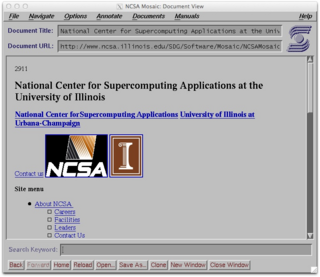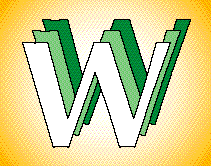Related Research Articles

AOL is an American web portal and online service provider based in New York City, and a brand marketed by Yahoo! Inc.
Netscape Navigator is a discontinued proprietary web browser, and the original browser of the Netscape line, from versions 1 to 4.08, and 9.x. It was the flagship product of the Netscape Communications Corporation and was the dominant web browser in terms of usage share in the 1990s, but by around 2003 its user base had all but disappeared. This was partly because the Netscape Corporation did not sustain Netscape Navigator's technical innovation in the late 1990s.
Netscape Communications Corporation was an American independent computer services company with headquarters in Mountain View, California, and then Dulles, Virginia. Its Netscape web browser was once dominant but lost to Internet Explorer and other competitors in the first browser war, with its market share falling from more than 90 percent in the mid-1990s to less than one percent in 2006. An early Netscape employee, Brendan Eich, created the JavaScript programming language, the most widely used language for client-side scripting of web pages. A founding engineer of Netscape, Lou Montulli, created HTTP cookies. The company also developed SSL which was used for securing online communications before its successor TLS took over.
A web banner or banner ad is a form of advertising on the World Wide Web delivered by an ad server. This form of online advertising entails embedding an advertisement into a web page. It is intended to attract traffic to a website by linking to the website of the advertiser. In many cases, banners are delivered by a central ad server. This payback system is often how the content provider is able to pay for the Internet access to supply the content in the first place. Usually though, advertisers use ad networks to serve their advertisements, resulting in a revshare system and higher quality ad placement.

NCSA Mosaic was among the first widely available web browsers, instrumental in popularizing the World Wide Web and the general Internet by integrating multimedia such as text and graphics. Mosaic was the first browser to display images inline with text.
WebCrawler is a search engine, and one of the oldest surviving search engines on the web today. For many years, it operated as a metasearch engine. WebCrawler was the first web search engine to provide full text search.

CompuServe, Inc. was an American online service, the first major commercial one in the world. It opened in 1969 as a timesharing and remote access service marketed to corporations. After a successful 1979 venture selling otherwise under-utilized after-hours time to Radio Shack customers, the system was opened to the public, roughly the same time as The Source.
O'Reilly Media, Inc. is an American learning company established by Tim O'Reilly that provides technical and professional skills development courses via an online learning platform. O'Reilly also publishes books about programming and other technical content. Its distinctive brand features a woodcut of an animal on many of its book covers. The company was known as a popular tech conference organizer for more than 20 years before closing the live conferences arm of its business.

Prodigy Communications Corporation was an online service from 1984 to 2001 that offered its subscribers access to a broad range of networked services. It was one of the major internet service providers of the 1990s.

eWorld was an online service operated by Apple Inc. between June 1994 and March 1996. The services included email, news, software installs and a bulletin board system. Users of eWorld were often referred to as "ePeople."
Spyglass, Inc. was an Internet software company. It was founded in 1990, in Champaign, Illinois, as an offshoot of the University of Illinois at Urbana–Champaign, and later moved to Naperville, Illinois. Spyglass was created to commercialize and support technologies from the National Center for Supercomputing Applications (NCSA). It focused on data visualization tools, such as graphing packages and 3D rendering engines.
AOLpress is a discontinued HTML editor that was available from America Online (AOL). It was originally developed as NaviPress by the company NaviSoft before being bought by AOL. It was discontinued in 2000. However, the last version (2.0) may still be found on some Web sites for downloading.

Dale Dougherty is a co-founder of O'Reilly Media, along with Tim O'Reilly. While not at the company in its earliest stages as a technical documentation consulting company, Dale was instrumental in the development of O'Reilly's publishing business. He is the author of the O'Reilly book sed & awk.

The World Wide Web is a global information medium that users can access via computers connected to the Internet. The term is often mistakenly used as a synonym for the Internet, but the Web is a service that operates over the Internet, just as email and Usenet do. The history of the Internet and the history of hypertext date back significantly further than that of the World Wide Web.
Ubique was a software company based in Israel. Founded in 1994, Ubique is notable for launching the first social-networking software, which included features such as instant messaging, voice over IP (VoIP), chat rooms, web-based events, and collaborative browsing. The company is best known for its most prominent product, Virtual Places, a presence-based chat program that allowed users to explore websites together. This software required both server and client components, enabling users to overlay avatars onto their web browsers and collaborate in real-time as they visited websites. Virtual Places was utilized by providers such as VPChat and Digital Space and eventually evolved into Lotus Sametime. Despite advancements and changes, some consumer-oriented communities still use older versions of Virtual Places.
NaviSoft was a web server, web publishing and web hosting company based in the United States that was the first company to offer an integrated solution that combined a high-performance programmable web server, NaviServer, with a WYSIWYG HTML authoring tool, NaviPress, and a public web site for hosting published pages, public.navisoft.com. NaviSoft was acquired by AOL on November 30, 1994.
InterCon Systems Corporation was founded in April 1988 by Kurt D. Baumann and Mikki Barry to produce software to connect Macintosh computers in environments that were not Macintosh-exclusive. At the time, there was no real concept of the Internet and there was still a question of whether the TCP/IP protocols or OSI protocols would be adopted widely. Over the next 9 years, the company grew from three employees to over 100 and sold software in the US, Europe and Japan.

Lisa Gansky is an American entrepreneur and author.

The First International Conference on the World-Wide Web was the first-ever conference about the World Wide Web, and the first meeting of what became the International World Wide Web Conference. It was held on May 25 to 27, 1994 in Geneva, Switzerland. The conference had 380 participants, who were accepted out of 800 applicants. It has been referred to as the "Woodstock of the Web".

MSN Dial-up is an Internet service provider operated by Microsoft in the United States and formerly also in several other countries. Originally named The Microsoft Network, it debuted as a proprietary online service on August 24, 1995, to coincide with the release of Windows 95. In 1996 and 1997, a revised web-based version of the ISP was an early experiment at interactive multimedia content on the Internet.
References
- ↑ Robbins, Jennifer N. (2018). Learning Web Design: A Beginner's Guide to HTML, CSS, JavaScript, and Web Graphics (5th ed.). O'Reilly Media. pp. xi. ISBN 978-1-491-96020-2.
- 1 2 3 "O'Reilly Internet Information Service (press release)". Computer Underground Digest. August 26, 1993. Retrieved June 5, 2013.
- 1 2 Tim O'Reilly (November 26, 2001). "O'Reilly Network Weblogs: SLAC Symposium on the Early Web". The O'Reilly Network. Archived from the original on 2001-12-22. Retrieved June 5, 2013.
- ↑ John Labovitz (June 17, 1994). "Re: Ads on a WWW content page". Coalition for Networked Information. Archived from the original on February 22, 2013. Retrieved June 5, 2013.
- ↑ "Electronic Commerce". Computer History Museum. Retrieved June 5, 2013.
- ↑ Tim O'Reily (April 30, 2005). "Ten–No, Eleven–Years of Internet Advertising". O'Reilly Radar. Retrieved June 5, 2013.
- ↑ Thomas Forbes (September 15, 1994). "Far out: Global Network Navigator is at the leading edge of the cyber frontier, pioneering an approach that may well represent the future for magazine publishers". Folio: The Magazine for Magazine Management. Retrieved June 6, 2013.
- ↑ "Awards". CERN's Access magazine. Fall 1994. Retrieved June 5, 2013.
- ↑ "Best O' The Net (press release)". Global Network Navigator. June 1, 1994. Retrieved June 5, 2013.
- ↑ Abbot Chambers (November 1, 1994). "Mortgages over the Internet (and related articles)". Mortgage Banking. Retrieved June 5, 2013.
- 1 2 3 4 Dale Dougherty (instructor) (Fall 1998). "Session 9, "Planning: GNN"". U.C. Berkeley SIMS IS-290 course, "Electronic Publishing". Retrieved June 5, 2013.
- 1 2 Philip Elmer-Dewitt (July 25, 1994). "Battle For The Soul Of The Internet". Time magazine. Archived from the original on February 5, 2012. Retrieved June 6, 2013.
- ↑ "What's New With NCSA Mosaic: Archives for January 1995". NCSA. January 2, 1995. Retrieved June 5, 2013.
- 1 2 3 Peter H. Miller (June 2, 1995). "Service Adds Another Portal To the Internet". New York Times.
- 1 2 Louis Trager (November 8, 1996). "AOL plans to absorb GNN". San Francisco Chronicle .
- 1 2 Peter H. Lewis (November 2, 1994). "Companies Rush to Set Up Shop in Cyberspace". New York Times.
- ↑ Jennifer Niederst Robbins (2009). "lGlobal Network Navigator (GNN)". littlechair.com. Archived from the original on June 3, 2013. Retrieved June 5, 2013.
- ↑ Dale Dougherty (October 1994). "GNN One Year Update". GNN (newsletter to subscribers). Archived from the original on April 26, 2012. Retrieved December 17, 2011.
- ↑ "Hostels Go On-Line". NY Daily News. May 21, 1995.
- ↑ "A ripening Internet market, secure systems". Fisher College of Business, Ohio State University. 1995. Archived from the original on June 24, 2013. Retrieved June 5, 2013.
- ↑ "American Red Cross and Global Network Navigator Establish Online Donation System For Victims of Kobe Earthquake (press release)". Free Online Library. January 31, 1995. Archived from the original on March 5, 2016. Retrieved June 5, 2013.
- ↑ Tim O'Reilly (February 22, 2009). "Why Kindle Should Be An Open Book". Forbes. Retrieved June 5, 2013.
- 1 2 Mary Fricker (June 2, 1995). "America Online to Buy GNN; Boon for Sebastopol-Based Company". Press Democrat.
- ↑ GNN press release (April 24, 1996). "GNN Gives the Next Generation Workforce A Look at an Internet Career as Part of Take Our Daughters to Work Day". PR Newswire. Archived from the original on March 5, 2016. Retrieved June 5, 2013.
- ↑ Rose Aguilar (March 12, 1996). "AOL goes for Explorer after all". CNET News . Retrieved June 5, 2013.
- ↑ "AOL unleashes Global Network Navigator at Internet World". Advertising Age. Retrieved June 5, 2013.
- ↑ "GNN'S second annual 'Best of the Net' awards celebrate the rich diversity and character of the global Internet community; twenty awards presented in gala event and Esther Dyson chosen as Netizen of the Year". Business Wire (GNN press release). November 4, 1995. Archived from the original on December 4, 2010. Retrieved June 5, 2013.
- ↑ "GNN tries to get hip with new show". CNET News. July 8, 1996. Retrieved June 5, 2013.
- ↑ Jeff Pelline and Janet Kornblum (October 29, 1995). "AOL shifts prices, execs". CNET News. Retrieved June 5, 2013.
- ↑ Jared Sandberg (October 30, 1996). "AOL Plans $385 Million Charge Related to Accounting Change". The Wall Street Journal.
- ↑ "AOL Time Warner Still Makes Sense". The Wall Street Journal . December 15, 2000.
- ↑ Joseph Tartakoff (January 8, 2011). "IPO Readiness: How Facebook And LinkedIn Compare To Previous Tech Giants". paidContent. Archived from the original on October 31, 2013. Retrieved June 5, 2013.
- ↑ "AOL cuts its workforce". Sun Sentinel. November 14, 1996. Archived from the original on December 1, 2015. Retrieved June 5, 2013.